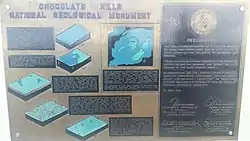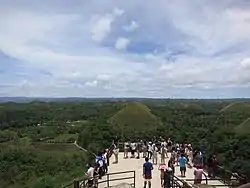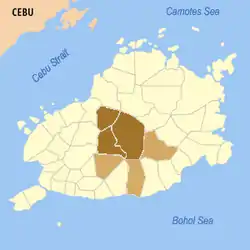Chocolate Hills
The Chocolate Hills (Cebuano: Mga Bungtod sa Tsokolate, Tagalog: Tsokolateng burol) are a geological formation in the Bohol province of the Philippines.[1] There are at least 1,260 hills but there may be as many as 1,776 hills spread over an area of more than 50 square kilometres (20 sq mi).[2] They are covered in green grass that turns brown during the dry season, hence the name.
| Chocolate Hills | |
|---|---|
 The Chocolate Hills in Carmen, Bohol | |
| Highest point | |
| Elevation | 120 m (390 ft) |
| Naming | |
| Native name | Mga Bungtod sa Tsokolate (Cebuano) |
| Geography | |
.svg.png.webp) Chocolate Hills .svg.png.webp) Chocolate Hills | |
| Geology | |
| Age of rock | Late Pliocene to Early Pleistocene |
| Mountain type | Conical karst hill range |
The Chocolate Hills is a famous tourist attraction of Bohol. They are featured in the provincial flag and seal to symbolize the abundance of natural attractions in the province.[3] They are in the Philippine Tourism Authority's list of tourist destinations in the Philippines;[4] they have been declared the country's third National Geological Monument and proposed for inclusion in the UNESCO World Heritage List.[4]
Description

The Chocolate Hills form a rolling terrain of haycock-shaped hills – mounds of a generally conical and almost symmetrical shape.[5] Estimated to be from 1,268 to about 1,776 individual mounds, these cone-shaped or dome-shaped hills are actually made of grass-covered limestone. The domes vary in sizes from 30 to 50 metres (98 to 164 ft) high with the largest being 120 metres (390 ft) in height. One of Bohol's best known tourist attractions, these unique mound-shaped hills are scattered by the hundreds throughout the towns of Carmen, Batuan and Sagbayan in Bohol.[6]
During the dry season, the grass-covered hills dry up and turn chocolate brown. This transforms the area into seemingly endless rows of Hershey's "chocolate kisses". The branded confection is the inspiration behind the name, Chocolate Hills.[4]
Vegetation
The vegetation of the Chocolate Hills is dominated by grass species such as Imperata cylindrica and Saccharum spontaneum. Several Compositae and ferns also grow on them. In between the hills, the flat lands are cultivated with rice and other cash crops. However, the natural vegetation on the Chocolate Hills is now threatened by quarrying activities.[7]
Origin
The Chocolate Hills are conical karst hills similar to those seen in the limestone regions of Slovenia, Croatia, northern Puerto Rico, and Pinar del Río Province, Cuba. These hills consist of Late Pliocene to Early Pleistocene, thin to medium bedded, sandy to rubbly marine limestones. These limestones contain the abundant fossils of shallow marine foraminifera, coral, mollusks, and algae.[8][9] These conical hills are geomorphological features called cockpit karst, which were created by a combination of the dissolution of limestone by rainfall, surface water, and groundwater, and their subaerial erosion by rivers and streams after they had been uplifted above sea level and fractured by tectonic processes. These hills are separated by well developed flat plains and contain numerous caves and springs. The Chocolate Hills are considered to be a remarkable example of conical karst topography.[10][11][12]
The origin for the conical karst of the Chocolate Hills is described in popular terms on the bronze plaque at the viewing deck in Carmen, Bohol. This plaque states that they are eroded formations of a type of marine limestone that sits on top of hardened clay.[13][14] The plaque reads:
The unique land form known as the Chocolate Hills of Bohol was formed ages ago by the uplift of coral deposits and the action of rain water and erosion.[13]
The plaque also makes reference to a fanciful explanation of the origin of the Chocolate Hills that is unsupported by any published scientific research, e.g. either Hillmer[8] or Travaglia and others,[9] when it states:
the grassy hills were once coral reefs that erupted from the sea in a massive geologic shift. Wind and water put on the finishing touches over hundreds of thousands of years.[13]
Self-published, popular web pages present a variety of fanciful and less credible explanations about how these hills formed. They include sub-oceanic volcanism; limestone covered blocks created by the destruction of an active volcano in a cataclysmic eruption;[15] coral reefs that were raised from the sea as the result of a massive geologic shift; and tidal movements.[16] The lack of any exposed or associated volcanic rocks anywhere in the Chocolate Hills refutes the popular theories involving volcanic eruptions. These theories involving either a sudden, massive geologic shift, coral reefs being erupted from the sea, or tidal movements lack any corroborating evidence and support among geologists.[8][9]
Legend
Three legends explain the formation of the Chocolate Hills. The first tells the story of two feuding giants who hurled rocks, boulders, and sand at each other. The fighting lasted for days, and exhausted the two giants. In their exhaustion, they forgot about their feud and became friends, but when they left they forgot to clean up the mess they had made during their battle, hence the Chocolate Hills.[13][17]
A more romantic legend tells of a giant named Arogo who was extremely powerful and youthful. Arogo fell in love with Aloya, who was a simple mortal. Aloya's death caused Arogo much pain and misery, and in his sorrow he could not stop crying. When his tears dried, the Chocolate Hills were formed.[18]
The third legend tells of a town being plagued by a giant carabao, who ate all of their crops. Finally having had enough, the townsfolk took all of their spoiled food and placed it in such a way that the carabao would not miss it. Sure enough, the carabao ate it, but his stomach couldn't handle the spoiled food, so he defecated, leaving behind him a mound of feces, until he had emptied his stomach of the food. The feces then dried, forming the Chocolate Hills.
Tourism

There are 1,247 hills, of which two have been developed into tourist resorts.[19][20]
The main viewing point of the Chocolate Hills is the government-owned Chocolate Hills Complex in Carmen, Bohol, about 55 km (34 miles) from the regional capital Tagbilaran.[21] The other main point to view the Chocolate Hills is at Sagbayan Peak, in Sagbayan, 18 km (11 miles) away from the Chocolate Hills complex in neighboring Carmen.[20]
Protection
Legislation
The National Committee on Geological Sciences declared the Chocolate Hills of Bohol a National Geological Monument on June 18, 1988, in recognition of its special characteristics, scientific importance, uniqueness, and high scenic value. As such, this included the Chocolate Hills among the country's protected areas. More protection was provided by Proclamation No. 1037 signed by then President Fidel V. Ramos upon the recommendation of the DENR on July 1, 1997 which established the Chocolate Hills and the areas within, around, and surrounding them located in the Municipalities of Carmen, Batuan and Sagbayan, Bilar, Valencia and Sierra Bullones, Province of Bohol as a natural monument to protect and maintain its natural beauty and to provide restraining mechanisms for inappropriate exploitation.[22] As such, they are covered under the National Integrated Protected Areas System (NIPAS) with the Department of Environment and Natural Resources (DENR) as the lead implementing agency for its protection.[23]
Land-use conflict prompted Philippine President Gloria Macapagal-Arroyo to sign an amendment to Proclamation 468 dated September 26, 1994 declaring the land around or in between Chocolate Hills as no longer part of the national monument during the Bohol Sandugo Celebration on July 17, 2002. This amendment allowed the tracts of land surrounding and within the famous tourist spot to be developed by the provincial government and other entities that have control over the area. Further, the amended proclamation ensures that the areas that have to be preserved are preserved, while those that could be developed would be excluded from the national monument area and classified as alienable and disposable by the government. The President initially decided on the issue during the joint meeting of the Regional Development Council-Regional Peace and Order Council (RDC-RPOC) of Region VII which was conducted at the Bohol Tropics Resort.<[24]
Bills have been filed aiming to strengthen protection of the hills. On July 6, 2004, the Philippine House of Representatives introduced House Bill No. 01147 entitled "an act declaring the Chocolate Hills as national patrimony and geological monuments, penalizing their plunder, destruction or defacement, and for other purposes." The house bill is authored by Congressman Eladio "Boy" Jala and co-authored by Congressman Roilo Z. Golez and Edgar M. Chatto.[23] Though this has not been passed into law.
On May 16, 2006, the Department of Environment and Natural Resources (DENR) submitted the Chocolate Hills to the UNESCO World Heritage for inclusion in the list of Natural Monuments because of its outstanding universal value, falling under criteria vii – superlative natural phenomena or areas of exceptional natural beauty and aesthetic importance. The protection, management, authenticity and integrity of properties are also important considerations.[4]
Amidst reports that quarrying has leveled off some of the mounds, Governor Erico Aumentado, the governor of Bohol, issued Administrative Order No. 3, series of 2006, which prohibits the issuance of quarry permits and favorable endorsements of mining permit applications in Carmen, Batuan and Sagbayan towns to forestall any degradation of the Chocolate Hills – no matter who applies for such.[25]
The hills are already declared geological monuments and are covered under the National Integrated Protected Areas System (NIPAS) for which the Department of Environment and Natural Resources (DENR) is the lead implementing agency. Aumentado said:
The provincial government is exerting every effort to preserve and maintain the natural wonder – including the plains between, connecting and surrounding them – since they are the major attractions in Bohol's tourism industry and a heritage to be shared with the world.[25]
As such, he ordered the prohibition of any quarrying and mining activities in the three towns. He tasked the Bohol Environment and Management Office (BEMO) to ensure that quarry permit applications or renewal thereof and requests for favorable endorsements of mining permit applications therein shall be denied due course, and to ensure compliance and enforcement of the order.[26] He also enjoined the Mines and Geosciences Bureau (MGB) of DENR to refuse all mining permit applications or renewals in the named towns.[25]
Issues
Balancing their protection, resource utilization and tourism are the challenges faced by the Chocolate Hills. Before they were designated national geological monuments, some of the hills (about 310,455 ha (1,200 sq miles)) were classified as alienable and disposable[27] or private lands such that they were titled to some locals. The declaration consequently caused some social unrest, resulting in almost simultaneous civil uprising, led by the long-established New People's Army (generally described as Maoist guerrillas) establishing a new front, known as the Chocolate Hills Command.[11] To some farmers, the proclamation is a government scheme which suppresses their right to own lands. As such, conflicts between the New People's Army group and government military forces escalated, culminating in two major engagements.[11]
Being alienable and disposable lands, the Chocolate Hills are seen as quarrying assets and source of income for small-scale miners, as well as quarry materials for the province's construction projects. The challenge is how the national and local officials can harmonize the current needs of small-scale miners, the construction sector and the tourism sector with the preservation of the Chocolate Hills.[28]
Even with their protected status, mining permits continue to be granted by DENR and local government units or LGUs.[25] Hence, mining and quarrying are still taking place. Because of this, the provincial government of Bohol has requested for the transfer of jurisdiction over the Chocolate Hills from the DENR to the provincial government of Bohol.[11]
Meanwhile, the provincial government has itself suggested that the legislation defining the Natural Monument should be changed, which will require that the proclamation be redrafted and ratified by both the Philippine House and Senate. This is a cumbersome and costly process, on which no progress has been made to date.[11]
There are also mounting complaints of mismanagement and poor service at the government-owned and operated Chocolate Hills complex and restaurant.[25] Added to this is the increase in the number of tourists visiting the Chocolate Hills which has caused traffic problems and safety issues, particularly in the Chocolate Hills complex in Carmen, Bohol.[29]
Future development and investment challenges within the Chocolate Hills area include: obtaining the national government's sanction for the project; persuading landowners to sell; convincing the Protected Areas Management Board or PAMB, which has jurisdiction over the hills, not to use its veto power over any investment requiring physical facilities.[30]
Since the natural monument proclamation bans "activity of any kind which will alter, mutilate, deface or destroy the hills." A 2003 amendment regulates activity among the privately owned areas "in between hills"
Filipinos are sensitive to perceived desecrations of so-called heritage sites. In 2003, a public outcry forced a construction firm to stop quarrying at the Chocolate Hills, and it was required to restore one defaced hill to its original shape.[30]
Investment challenges include speculators bidding up property prices in the area, raising the potential cost of a proposed project.[30] Persuading investors to put their money into the poorer parts of Bohol is complicated by communist guerrillas who extort money from local officials.[30] Following his refusal to pay the extortion, Mayor Torrefranca of Sagbayan, Bohol has survived two assassination attempts since 1998.[30] In the 1998 elections, his car was torched due to his failure to pay the "permit to campaign fee".[31]
References
- Eye on the Philippines Archived 2006-12-08 at the Wayback Machine Global Eye Retrieved 22 December 2006.
- Chocolate Hills Archived 2015-04-09 at the Wayback Machine Seven Natural Wonders. Retrieved 10 December 2011.
- The Bohol Flag and Seal Archived 2007-04-08 at the Wayback Machine www.bohol.gov.ph Retrieved 15 November 2006.
- Chocolate Hills Natural Monument UNESCO World Heritage Centre Retrieved 14 November 2006.
- Bohol: The Jewel Paradise of the Philippine Islands www.bohol.net Retrieved 15 November 2006.
- Bohol Archived 2006-11-17 at the Wayback Machine www.dotpcvc.gov.ph Retrieved 15 November 2006.
- Bohol Island Herbarium www.pnh.com.ph. Retrieved 14 November 2006.
- Hillmer, G., 1987, Zur geologie und morphologie der straandterrassen von Cebu und Bohol Philippinen. Berliner geographische Studien. v. 25, p. 363–376.
- Travaglia, C., R. Peebles, E. Bate, and A. Ferrer, 1987, Reconnaissance groundwater appraisal of Bohol Island, Philippines, by satellite data analysis. RSC Series no. 38. Food and Agriculture Organization of the United Nations, Rome, Italy.
- Restificar, S. D. F., M. J. Day, and P. B. Urlich, 2006, Protection of Karst in the Philippines (Varstvo Krasa na Filipinih)., 788 KB PDF version. Acta Carsologica. v. 35, no. 2, p. 121-130.
- Urlich, P. B., M. J. Day, and F. Lynagh, 2001, Policy and practice in karst landscape protection: Bohol, the Philippines. The Geographical Journal. v. 167, no. 4, pp. 305-323.
- Leman, S. L., A, Reedman, and C. S. Pei, 2008, Geoheritage of East and Southeast Asia., 5.7 MB PDF version. The CCOP-Institute for Environment and Development, Universiti Kebangsaan, Bangi Selangor, Malaysia.
- Chocolate Hills: Philippines Vacation www.philippinesvacation.org Retrieved 15 November 2006.
- Bohol Archived 2007-01-15 at the Wayback Machine www.philippines.hvu.nl. Retrieved 15 November 2006.
- Bohol www.tambuli.com. Retrieved 15 November 2006.
- "Move over Boracay: Panglao Island beckons". inq7.net. Archived from the original on 2004-12-17. Retrieved 2008-10-14.
- Bohol Chocolate Hills legend will bring a tear to your eye www.philippines-travel-guide.com. Retrieved 15 November 2006.
- The Chocolate Hills www.bohol.ph. Retrieved 14 November 2006
- Bohol God's little Paradise Archived 2006-12-21 at the Wayback Machine library.thinkquest.org. Retrieved 22 December 2006
- Chito A. Fuentes. "Sagbayan Peak: A View from the Top". Philippine Daily Inquirer. Archived from the original on 2005-11-10. Retrieved 2008-10-14.
- Bohol Island Sightseeing Archived 2006-09-03 at the Wayback Machine Bohol Island Hotels Travel Guide. Retrieved 15 November 2006.
- "Proclamation No. 1037, s. 1997". Official Gazette of the Republic of the Philippines. Manila, Philippines. 1 July 1997. Retrieved 4 May 2020.
- "History of Bill; NO. HB01147". House of Representatives of the Philippines. 23 March 2006. Archived from the original on 28 March 2006. Retrieved 4 May 2020.
- "GMA seeks development of parts of Chocolate Hills". The Official Government Portal of the Republic of the Philippines. 17 July 2002. Archived from the original on 27 September 2007. Retrieved 4 May 2020.
- "The Official Website of The Bohol Chronicle". Boholchronicle.com. Archived from the original on December 7, 2008. Retrieved 2008-10-13.
- Gov issues orders to protect Choco Hills Bohol Sunday Post Retrieved 14 November 2006.
- "Bohol Philippines - Splendour Underwater And Over Hills". TravelOnline Inc. 2000. Archived from the original on March 31, 2007. Retrieved 2008-10-13.
- CV gh Context of PA 21 Archived 2007-02-26 at the Wayback Machine www.neda7.net.ph. Retrieved 17 November 2006.
- PNP takes action on Choco traffic www.boholchronicle.com. Retrieved 15 November 2006.
- Toontown comes to Bohol's Nature Park Archived 2007-09-27 at the Wayback Machine www.newsflash.org. Retrieved 14 November 2006.
- Bagaipio, Kit (2007-02-18). "Army commander warns politicians from giving to "rebel" extortionists". The Bohol Chronicle. Archived from the original on September 5, 2008. Retrieved 2008-10-14.
